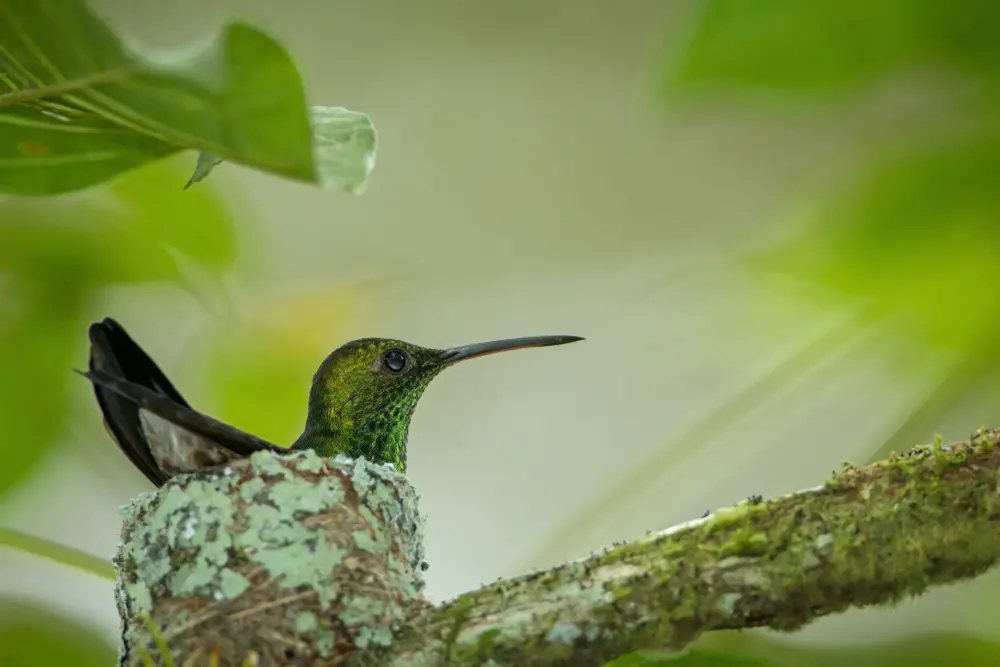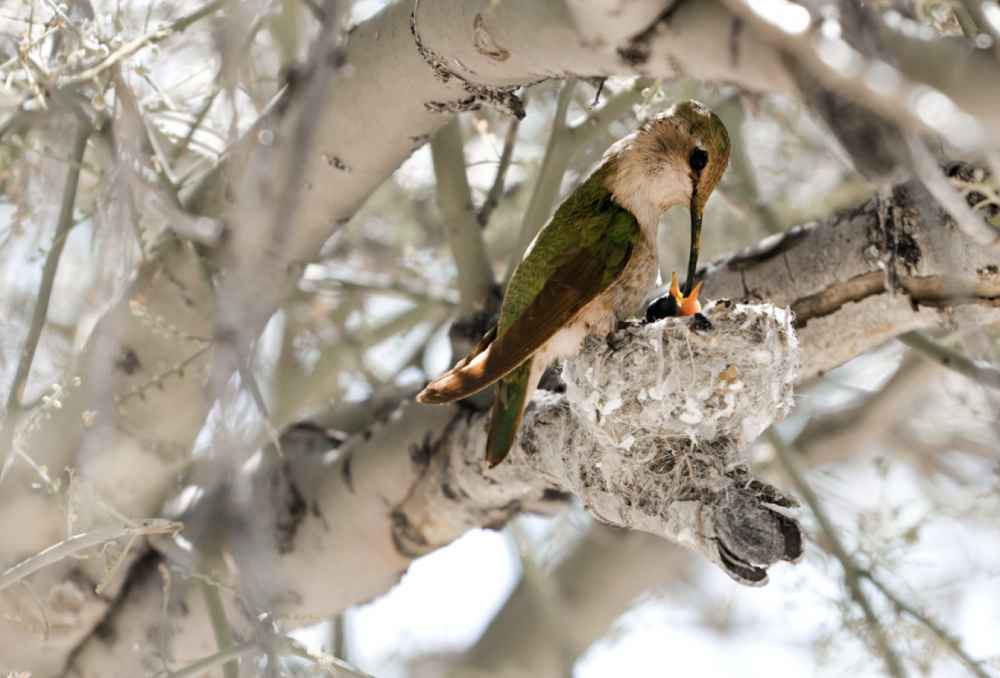Hummingbirds are tiny creatures with a list of predators that makes areas heavy with foliage an important factor in their overall safety.
So, where do hummingbirds nest? Hummingbirds typically nest in small bushes and trees on the forks of branches where they can find an ample amount of protection from rain, wind, sun, and predators while also meeting the needs of environmental factors.
Basic Shelter Requirements

In general, hummingbirds will nest in trees or shrubbery that supplies them with both food and protection, this way they do not have to travel far from their eggs or expend more energy than necessary.
They will typically build their nests anywhere from 3 feet to 60 feet above the ground and might be as far away as half a mile from feeding grounds.
Where they build their nest must also supply them with an adequate amount of leafy protection from the elements.
Barriers against the wind, rain, sleet, snow, high temperatures, and visual concealment from their predators is a priority for these tiny creatures and their jellybean sized eggs.
But if you love these attractive hummers around you, check out this post on “how to attract hummingbirds?”
Protective Quality of Foliage- A Canopy Barrier
Heavy foliage is an important nesting quality for several reasons.
Despite hummingbirds not being cavity dwellers, nesting locations that provide all-around concealment aid a hummingbird in their protection against harsh weather and a heavy list of predators.
Nesting Against the Threat of Harsh Weather

Hummingbirds are tiny creatures that weigh less than an ounce, with their eggs weighing significantly less in comparison to an adult hummingbird.
As a result of their small size, any strong gusts of wind or heavy downpour can potentially harm them, either by being swept off by the wind or pelted down by the rain.
For hummingbirds, leafy clusters of trees and shrubs act as the walls of a house, blocking out a significant amount of rain and wind for hummingbirds to shelter from harsh weather conditions.
Nesting Against the Threat of Predators
The heavy canopy of leaves also has the bonus of not just blocking out rain droplets but also obscuring the view of a hummingbirds’ nest from the aerial view of predators.
Hummingbirds have many predators, including predatory birds (like owls, corvids, etc.), squirrels, chipmunks, cats, snakes, and bats, making it all the more important that their nesting area be properly shielded from view.
In addition to leafy trees and shrubs, thorny bushes are common nesting areas for hummingbirds as an added layer of protection against predators.
Popular Nesting Locations
As with any animal, specific habitat qualities play an important role in a hummingbird’s selection of nesting locations.
So, where do hummingbirds nest in winter? Many species of hummingbirds that endure colder climates prefer to build their nests by meadows, orchards, perimeters of forests, and streams in conifer trees, cottonwood, willows, and alder trees as they supply more warmth.
For hummingbirds that live in warmer climates, they prefer to nest in maple, birch, oak, elm, and sycamore trees that supply them with more water retention in their leaves.
They often choose to nest near bodies of water as it also helps to relieve how hot their nesting area is and protects their eggs from extreme heat.
How do female hummingbirds choose the nest location?

Before nesting, female hummingbirds land on the nest several times and test the strength of the perch.
Hummingbirds are too tiny and weigh so little that any perch becomes suitable for their nest. Therefore, they check the stability that can hold the nest as well as their growing chicks.
Generally, hummingbirds build their nest 3-60 feet above the ground and not more than half a mile away from the food sources.
Conclusion
Protection is always the driving factor of where a hummingbird nest?
However, they check the nesting locations but their nests don’t last for more than one season. The presence of food source to the nearest location is what they need?
Related Questions
What kind of trees do hummingbirds like to nest in? Hummingbirds usually build their nest around the water body that keeps their nesting area cools. The trees on which they usually nest are elm, sycamores, poplar, maples, birch, oaks, and fruitless mulberry.
Do hummingbirds return to the same nest? Most of the hummingbirds return to the same nest but since their nests are not long-lasting they don’t last more than a season. But they build their nest at the same place again.
How do you find a hummingbird nest? The best way to look for the hummingbird’s nest around the trees in your garden if you know that there are hummingbirds in your locality.
What do hummingbirds use for nesting material? The nesting materials used by hummingbirds are Mosses, lichens, feathers, leaf fuzz, Spider silk to bind the nest and bits of bark,


